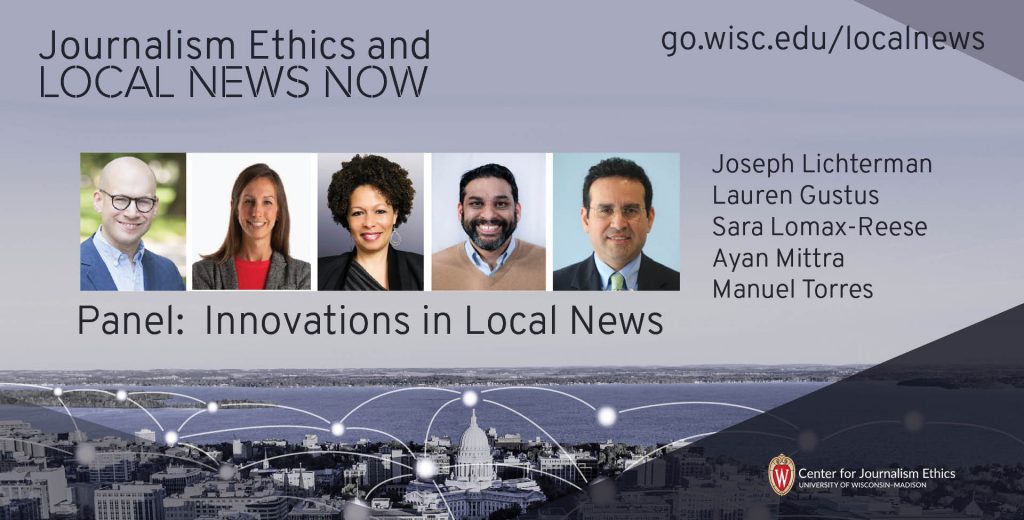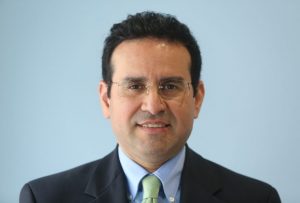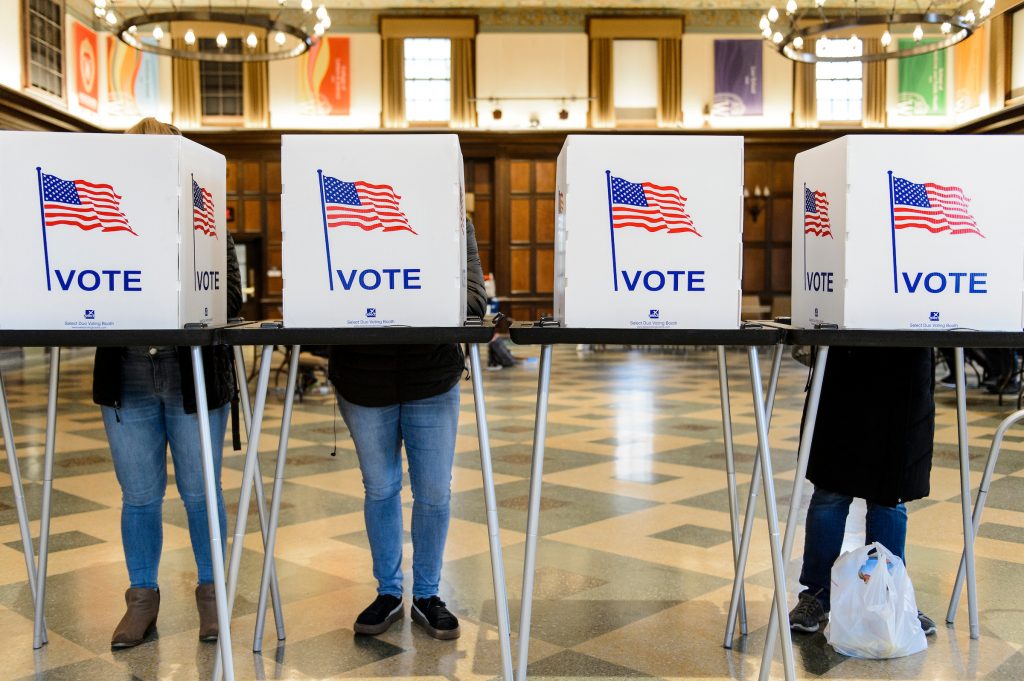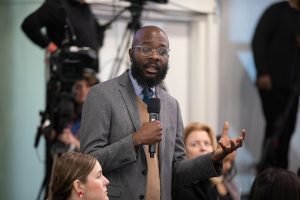
Knoxville, TN, as seen from the top edge of Neyland Stadium
Journalists have always had to grapple with how to cover extremists and hate-filled ideologies. But in today’s digital world, and with experts warning about the threat of white supremacy and far-right extremism, journalists are taking a new look at how to cover such stories.
News organizations must report on these topics without amplifying and spreading hateful messages. The Knoxville News Sentinel faced this test earlier this year after a Knox County detective and pastor gave a sermon preaching extremely anti-LGBTQ rhetoric. When reporting on the story, the Sentinel decided against including videos of the sermons or directly quoting from it.
Joel Christopher, executive editor of the newspaper, discussed this decision and the challenges of covering extremism in a recent interview with the Center for Journalism Ethics.
This interview has been edited for length.
Walk us through the decision to not include the video or directly quote from it in these stories.
I’ve always had some level of discomfort with giving a platform to extremists in our coverage. I think there’s a tendency to over-cover them at times and to give them way more space or bandwidth than they deserve. You’re actually playing into distributing their message. This has been in my head for as long as I’ve been a journalist.
Recognizing at the same time you do have to balance the fact that you have to report on this. You can’t just bury it because people have to understand what’s happening in their communities and be prepared to tackle tough issues that arise around these extremists.
I think there’s a recognition, particularly in the digital era, that you have to be really smart about what you’re doing with your content. The fact that a lot of these extremists have gotten pretty savvy about understanding that there are certain triggers they pull that will initiate coverage from news organizations, particularly at the local level. Once that gets out into the world digitally, it often gets picked up and distributed over and over again by organizations that have much larger reach than any of these extremist groups would have had on their own. At some point you’ve got to ask yourself how much you’re being played to distribute their message on your platforms.
So when the Fritts’ case broke, my initial reaction was “let’s not put the video out there, it’s not necessary.” You can explain that the video exists, you can explain what’s in the video but there’s no reason that you have to put that particular inflammatory language out there without context. Even with context you’re still amplifying it.
That runs counter to a lot of natural instincts from journalists, particularly in the digital era. Where the idea is: more access to everything, let readers make their own decisions and it’s going to be out there anyway, and they can find it. Ultimately, we decided in this case, let’s not do it.
We can see that this guy and his group are intentionally putting out a series of different videos that seem designed specifically to trigger media coverage. They got increasingly more inflammatory, it’s like they tried a couple times, and no one bit on it. The one that got our attention came to us through somebody who said they used to be part of that church and weren’t anymore. I had some suspicion about whether or not that was true. It felt like it was designed to put it right in our laps and make sure that we would cover it.
The positive part of it from my view was that I know that video didn’t get seen as much as it would have if we’d put it out there. We still absolutely accurately explained what the extremists’ message was for people in a way that they could act on it, without doing it in a way that inflicted damage on the communities that were targeted. All the reactions that you would hope to come out of coverage like that still occurred, but without amplification and inflicting damage on communities that were targeted. There was no attempt to submerge the coverage or to whitewash it to the extent that you couldn’t tell how awful the message really was. But it was in our words not the extremist’s words.
Are decisions like this made on a case-by-case basis? Or do you take a more general approach?
We’re part of a nationwide network of newsrooms [USA Today], our company wisely doesn’t mandate blanket policies in how local coverage decisions are made. Other than that, they comply with our principles of ethical conduct for newsrooms. But there’s room within those principles for a traditional type of approach and the approach that I described.
That’s a long way of saying I think we would still consider it on a case-by-case basis. But I can tell you that I’m done directly putting out hate-filled messages in a way that gives them massive amplification. I think it’s ludicrous. Part of being a news organization is not being played, not being used to be an instrument of propaganda. We think about that all the time in political coverage. We don’t often use the canned quotes that you see in a news release from a Democratic or Republican party spokesperson, we talk directly to the public official. We don’t use that language that is designed as much for fundraising as it is for actual adding to the political conversation. So why would we switch our standards for extremists?
Some of it, like all things in life, aren’t new. During the civil rights movement newspaper editors and publishers sort of had an “aha” moment. You don’t need to put all your effort into covering the segregationists and the advocates of Jim Crow. You cover the people who are trying to change that system, and that changes the narrative of what’s happening, and it changes the conversation around those efforts. And can you say there’s advocacy in that decision making? Sure, it’s advocacy in favor of weighting the scale on the side of human rights and dignity over hatred and extremism. That’s a place I think any publisher or editor can safely land and defend.
What techniques and methods can you use to balance drawing the public’s attention to these types of stories while not spreading an extremist’s message?
I think the answer to that is really easy. There’s no news organization in Knoxville that covered Detective Fritts more than we did. And there’s no news organization that reached more people in coverage than we did. And we very clearly explained what his message was. We just did it in our language, instead of his.
Fundamentally what his call was, was state-initiated arrests and execution of LGBTQ people. Now he said it in ways that I would never say it, and I won’t dignify it by saying it the way he said it. But I just explained to you very clearly what he said. And you can get the impact and the horror of that statement without me saying it in his words. And we didn’t shy away from being very clear that’s what he was saying. But we just don’t owe anybody, including our audience, an unfiltered pipeline from the extremist to the receiver of that message. It’s not hard to go find what he did and what he said. But I don’t need to take you directly to it.
There’s another component that doesn’t get into the conversation often enough. From a pure mechanics of how the digital world functions; in search [engines], established reputable news organizations are the gold standard in terms of referrals. Every time we directly link to something like that, we’re telling search engines “this is good content, this is content you ought to direct people to.”
We’re giving them an endorsement in some sense. A spider that’s searching the web doesn’t understand that there is good content and bad content based on us linking to it, they just know that we linked to it so it’s “good” content. Why would we put that powerful endorsement onto content that we think is abhorrent? From a purely technical issue you have to be very thoughtful about it.
Thirty people would see a video like this if we don’t link to it. We link to it with an audience of millions? You have to be smart about that. We put more thought into the inadvertent obscenity that might appear in a raw video of a police shooting for instance. And there are lots of news organizations, and I’ve been in the middle of these coverage efforts, where you don’t think twice about putting out someone calling for violence or suppression of rights against minority groups, under the guise that it’s necessary for people to know what’s out there.
How do you determine when to label someone or an organization a white supremacist, and what are the ethical implications of that language?
I think the Associated Press has done a really nice job taking news organizations through that thought process and making sure that you fully understand what the terms mean. Our own organization, the USA TODAY NETWORK, has thoughtful guidelines to talk you through when that’s appropriate language.
There are also great organizations who study these groups for a living, Southern Poverty Law Center, for instance. They don’t lightly attach extremist labels to groups because they want to reserve it for those that truly fit that description. I think following that thought process in news coverage is useful, as well. It’s never a decision that would be made lightly at a level in the news organization that wouldn’t require approval all the way through the organization.
How has news coverage of these types of stories changed as the digital world has grown and messages spread more rapidly?
A good analogy to how coverage has evolved on this is The Westboro Baptist Church. They figured out how to trigger media long before anybody else did and got really good at getting coverage everywhere. By the end they were so effective at it they weren’t even showing up at places. All they had to do to trigger coverage in a community was send out a release saying they were coming there. It took a long time for news organizations to figure that out.
Finally, enough smart editors said, “What are we doing here, why are we covering those guys? Why are you inflicting this hate-filled message on a minority community without thinking about what the effect is on folks? There’s not a debate here that’s going on about different schools of thought on American Constitutional rights. It’s the equivalent to extremist trolling.”
I think some of that same thought process has gone into coverage of other extremists. There are times in my career where, if you had the ability to put a video out there, why wouldn’t you? We can see it, why shouldn’t everybody else see it? Nobody’s a gatekeeper.
Now I think there’s more of a realization that no, you’re not a gatekeeper in the sense that you could have been in a pre-digital era where you really could keep something away from the vast majority of people. But you can still be a gatekeeper on the standards of what you put in front of large audiences. Whatever people want to say about media these days, your news organization is still the biggest one in town and still has the biggest local audience digitally. Think about if you want to lend that audience to extremists.
In the past, I probably would have put a video up. Maybe would have done an explicit language warning. Or maybe if we didn’t put the video up, we still would have quoted very directly and extensively from it and have been very clear where people could find it. A lot of those things we’ve definitely rethought. I guarantee if you call 20 of my colleagues, you would get some different schools of thought. Which is OK too, I’m not pretending that I have the only and correct answer here.
Law enforcement agencies continue to warn that far-right groups and white supremacists are a growing threat. Do news organizations have a role in combating that threat?
On issues of law enforcement, our role is the same as it’s always been. We’re not agents of law enforcement, and we should never consider ourselves to be. How law enforcement combats that are entirely different questions from how we cover it. We should never be comfortable to be in collaboration with law enforcement on strategies involving extremists.
What we should be concerned about is what are our constitutional obligations to cover both those groups and government reaction to it? And what’s the interplay between those interactions with the constitutional rights of those who aren’t extremists.
Some of the best First Amendment law came out of really offensive speech in a lot of cases. So you have to be really careful about calling for some sort of ban or trying to erase the fact that these groups are out there, that’s not the intention at all. But you have to report on it in a thoughtful manner.
What can national news organizations learn from local newsrooms when it comes to covering these types of stories?
All national stories start local. That sounds obvious, but people don’t think about that sometimes. It’s just that they resonate in some way that goes beyond the particular local audience. News organizations that have national reach need to be super thoughtful of the fact that their ability to amplify is so much more powerful. The thought they put into it has to be measured with that power. I think a lot of national news organizations do a pretty darn good job of it. I think in a lot of cases, they have more structure in place and more process that they don’t generally lightly make decisions to post things without a lot of thought about what the message is.
But they make mistakes too. However you fell on it in the end, The Covington Catholic experience showed news organizations that there needs to be a checklist in place for how you vet video that you post. And I think those same principles could apply to any inflammatory or extremist content as well. It’s important that the national news organizations, and local news organizations, are clear about how and why they’re doing what they’re doing.
For more guidance in reporting on extremism, please see this tip sheet from Journalist’s Resource.
The Center for Journalism Ethics encourages the highest standards in journalism ethics worldwide. We foster vigorous debate about ethical practices in journalism and provide a resource for producers, consumers and students of journalism. Sign up for our quarterly newsletter here.









